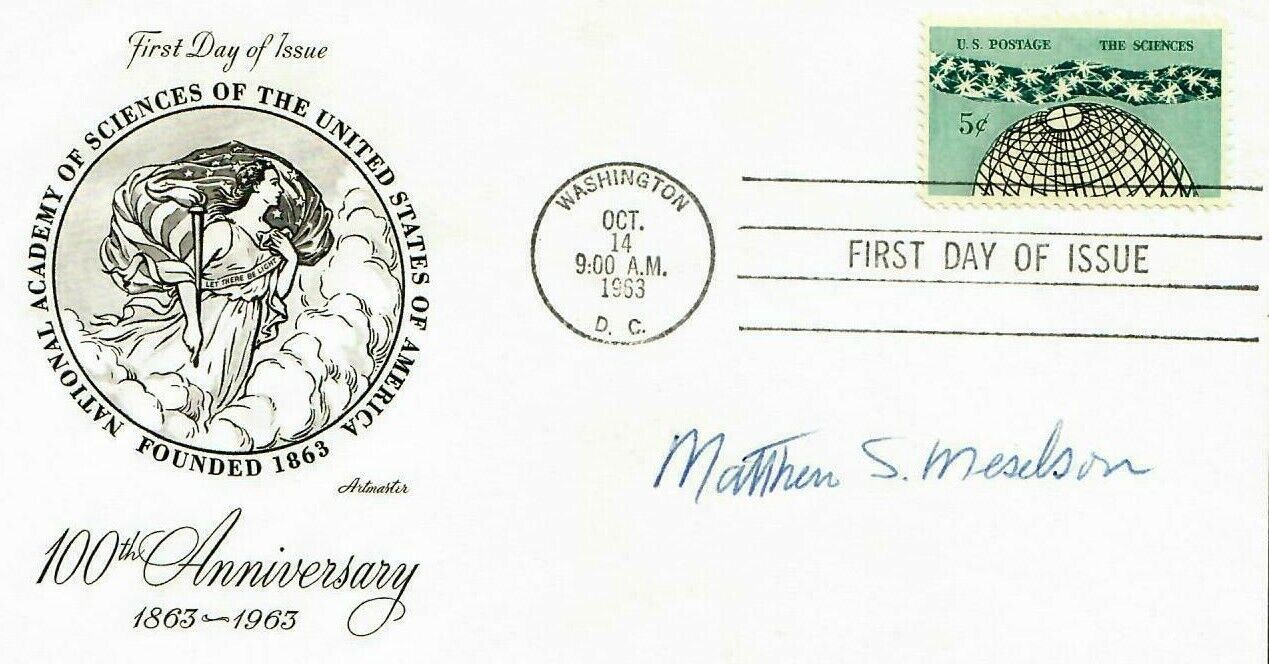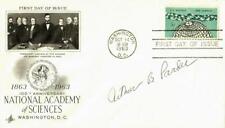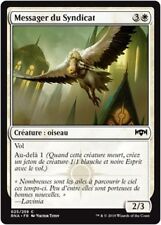\"Messenger RNA\" Matthew Meselson Hand Signed FDC Dated 1963 For Sale

When you click on links to various merchants on this site and make a purchase, this can result in this site earning a commission. Affiliate programs and affiliations include, but are not limited to, the eBay Partner Network.
\"Messenger RNA\" Matthew Meselson Hand Signed FDC Dated 1963:
$489.99
Up for sale "Messenger RNA" Matthew Meselson Hand Signed First Day Cover Dated 1963.
May 24, 1930) is a geneticist and molecular biologist currently
at Harvard University, known
for his demonstration, with Franklin Stahl, of semi-conservative DNA replication. After completing his Ph.D under Linus Pauling at the California Institute of
Technology, Meselson became a Professor at Harvard University in
1960, where he has remained, today, as Thomas Dudley Cabot Professor of the
Natural Sciences. In the famous Meselson–Stahl experiment of
1958 he and Frank Stahl demonstrated
through nitrogen isotope labeling that DNA is
replicated semi-conservatively. In addition, Meselson, François Jacob, and Sydney Brenner discovered the existence of messenger RNA in 1961. Meselson has investigated DNA
repair in cells and how cells recognize and destroy foreign DNA, and,
with Werner Arber, was
responsible for the discovery of restriction enzymes. Since
1963 he has been interested in chemical and biological defense and arms
control, has served as a consultant on this subject to various government
agencies. Meselson worked with Henry Kissinger under the Nixon administration to
convince President Richard Nixon to renounce biological weapons, suspend
chemical weapons production, and support an international treaty prohibiting
the acquisition of biological agents for hostile purposes, which in 1972 became
known as the Biological Weapons
Convention. Meselson has received the Award in Molecular Biology
from the National Academy of
Sciences, the Public Service Award of the Federation of American
Scientists, the Presidential Award of the New York Academy of
Sciences, the 1995 Thomas Hunt Morgan Medal of
the Genetics Society of America, as well as the Lasker Award for Special Achievement in Medical Science.
His laboratory at Harvard currently investigates the biological and
evolutionary nature of sexual reproduction, genetic recombination, and aging.
Many of his past students are notable biologists, including Nobel Laureate Sidney Altman, as well as Mark Ptashne, Susan Lindquist, Stephen F. Heinemann,
and Richard I. Morimoto. Meselson
was born in Denver, Colorado, on May 24, 1930 and attended elementary and
high-school in Los Angeles, California. While a young child he was interested
in chemistry and physics, and conducted many experiments in the natural
sciences at home. During World War II, Meselson attended summer school during summer
vacations and received enough high school credits to graduate a year and a half
ahead of time. When he attempted to acquire his diploma from the registrar at
his high school, however, he was informed that in order to receive his high
school diploma, he needed three full years of physical education, which he
lacked. After searching for options, he enrolled at the University of Chicago at
the age of 16 in 1946 intending to study Chemistry, since it did not require a
high school diploma to attend. In
1957, Meselson and Franklin Stahl (as
part of the phage group) showed that
DNA replicates semi-conservatively. In order to test hypotheses for how
DNA replicates, Meselson and Stahl, together with Jerome Vinograd, invented a method that separates
macromolecules according to their buoyant density. The method, equilibrium density gradient
centrifugation, was sufficiently sensitive that Meselson and Stahl were able to
separate DNA containing the heavy isotope of nitrogen, 15N,
from DNA made of the lighter isotope, 14N. In their classic
experiment, described and analyzed in a book by science historian Frederic L.
Holmes, they grew the bacterium Escherichia coli for many
generations in medium containing 15N as the only nitrogen
source and then switched the bacteria to growth medium containing 14N
instead. They extracted DNA from bacteria prior to switching and, at intervals,
for several generations thereafter. After one generation of growth, all the DNA
was seen to have a density half way between that of 15N DNA
and 14N DNA. In successive generations, the fraction of DNA
that was "half-heavy" fell by a factor of ½, as the total amount of
DNA increased two-fold. When the half-heavy DNA was made single stranded by
heating, it separated into two density species, one heavy (containing
only 15N) and one light (containing only 14N).
The experiment implied that, upon replication, the two complementary strands of
the bacterial DNA separate, and that each of the single strands directs the
synthesis of a new, complementary strand, a result that verified the suggestion
for DNA replication put forward five years earlier by James Watson and Francis Crick and lent important early support for the
Watson-Crick model of the DNA molecule. In collaboration with Jean Weigle, Meselson then applied the density gradient method
to studies of genetic recombination in the bacteriophage Lambda. The question
was whether such recombination involved breakage of the recombining DNA
molecules or cooperative synthesis of new molecules. The question could be
answered by examining phage particles derived from co-infection of bacteria
with genetically marked Lambda phages that were labeled with heavy isotopes (13C
and 15N). The density-gradient method allowed individual
progeny phages to be characterized for their inheritance of parental DNA and of
parental genetic makers. Meselson's initial demonstration of
breakage-associated, replication-independent recombination was later found to
reflect the activity of a special system that can recombine Lambda DNA at only
one spot, normally used by the phage to insert itself into the chromosome of a
host cell. Subsequently, variations of the experiment by Franklin Stahl
revealed reciprocal dependencies between DNA replication and most genetic
recombination. With Charles Radding, Meselson developed a
model for recombination between DNA duplexes that guided research in the field
for the decade from 1973 to 1983. In
1961, Sydney Brenner, François Jacob and Meselson used the density-gradient
method to demonstrate the existence of messenger RNA In subsequent work,
Meselson and his students demonstrated the enzymatic basis of host-directed
restriction, a process by which cells recognize and destroy foreign DNA
and then predicted and demonstrated methyl-directed mismatch repair, a process that enables cells to correct
mistakes in replicating DNA. Meselson's current research is aimed at
understanding the advantage of sexual reproduction in evolution. Meselson and
his colleagues have recently demonstrated that Bdelloid rotifers do, in fact,
engage in sexual reproduction employing meiosis of an atypical sort.

Related Items:
"Messenger RNA" Matthew Meselson Hand Signed FDC Dated 1963
$489.99
"Messenger RNA" Arthur Pardee Hand Signed FDC Dated 1963
$209.99
MTG Magic RNA - (x4) Syndicate Messenger/Messager du Syndicat, French/VF
$1.09



